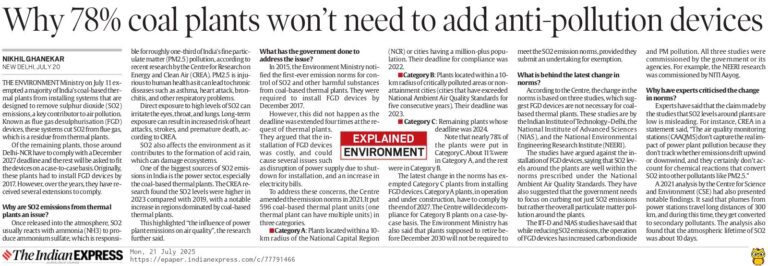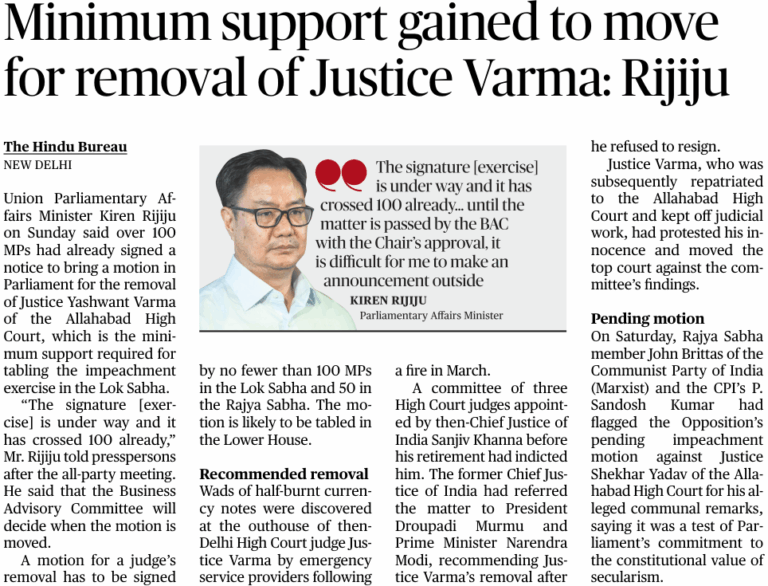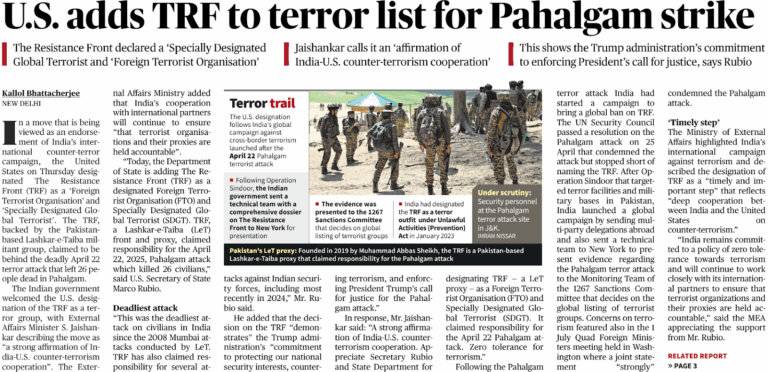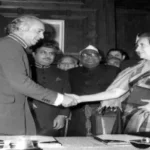How is President’s Rule Imposed? (Article 356)
Why in the news?
- May 27, 2025, staged women in Imphal West, Manipur, a thorough protest against the implementation of the President’s Board of Directors in the State, which has been effective since February 2025.
- In a long constitutional vacuum for a long time, ten MLAs met the governor and sought a representative government.
- Due to the remaining two years remaining in the state target, protesting citizens emphasise the demand to increase unrest, democratic concerns and political responsibility.
- The case has decided the national debate on the role of the governor and courts in maintaining federal values , along with Article 356 of the Indian Constitution and its historical abuse.
Background: What is the president’s board?
The president’s board refers to the suspension of the state government and the direct administration of the state by the central government in accordance with Article 356 of the Constitution of India. This gives the president the right to take over the state leader when constitutional mechanisms in a state collapse.
Article 356 reads
- “If the president receives a report from the Governor or otherwise, it is pleased that a situation has arisen where the government cannot be done under the provisions of this Constitution, the president may consider himself or any work for all the state’s functions.”
- Article 356 is often read by Article 365, which allows the president to work if one fails to follow instructions from the Union.
- The announcement from both the Parliament House should be confirmed within two months. When approved, the president’s rule remains valid for six months and can be expanded with parliamentary approval for three years.
Features of President’s Rule
- Proclamation Based on Governor’s Report or Otherwise
- While typically triggered by a Governor’s report citing constitutional breakdown, the President can also act suo motu, relying on intelligence inputs or other credible information.
- Parliamentary Oversight
- The need for ratification by both Houses ensures parliamentary scrutiny. However, only a simple majority is required.
Period of Validity
- The President’s Rule is valid for six months, extendable every six months for up to three years, under Article 356(4). Extension beyond one year requires:
- The Election Commission certifies that elections cannot be held in the State.
Suspension of the State Legislature
During President’s Rule, the Legislative Assembly may either be dissolved or kept under “suspended animation.” The latter allows for revival if political stability returns.

Executive Power Vested in the Union
- The President (through the Governor) assumes all executive powers. The State Council of Ministers is dismissed, and legislative powers of the State are exercised by the Parliament.
Historical Context: From a Dead Letter to a Political Tool
- Dr. B.R. Ambedkar hoped that Article 356 would remain a “dead letter.” However, history has proven otherwise.
- Early Misuse: The first use of Article 356 occurred in 1951 in Punjab. Between 1951 and 1990, Article 356 was used over 90 times, often to dismiss opposition-led State governments.
- Indira Gandhi Era (1966–1977): Witnessed the maximum misuse. In 1977, after losing the Lok Sabha elections, the Janata Party dismissed nine Congress-ruled States.
1980s – 1990s: President’s Rule was increasingly used as a political weapon rather than a last-resort constitutional remedy.
Examples:
- Kerala (1959): First major dismissal of a democratically elected communist government under Nehru.
- Bihar (2005): Dismissal overturned by the Supreme Court for being unconstitutional.
- Uttarakhand and Arunachal Pradesh (2016): Courts again restored dismissed State governments.
The Governor’s Role: Incompatibility and Conscience
The governor plays an important role in triggering the president’s board, and his discretionary powers have often been controversial. Inconsistent advice on resolution. There is a lack of uniformity in the decision to dissolve the rule regarding the postal mounts. For example:
- In Kerala (1970) and Punjab (1971), the congregations were dissolved according to the advice of the chief ministers, who had a majority shortage.
- But in similar cases – Punjab (1967), Uttar Pradesh (1968) and Madhya Pradesh (1969) – 1969) – were legislative assemblies were placed in suspended animation and demanded alternative governments.
This reflects inconsistent standards and subjective discretion of governors, often driven by political affiliation.
Post- S.R. Bomai expectations
- SR in the Supreme Court made the Bomai case clear that the governor’s report should be targeted and not politically motivated. Despite this, reports from governors continue to face claims of bias.
- Judge’s Interpretation: The Bomai principle
- For decades, the courts maintained a hand -closed approach to implement the president’s order. Changed with that:
Primation Bomai vs India (1994)
- A constitutional bench gave a historical decision, which meets the following principles:
- Judge review is allowed: The court can investigate whether there was relevant material behind the announcement.
- The wrestling of constitutional machines: Only law and order problems are inadequate.
- The legislative assembly should not be dissolved: The assembly can only be suspended until parliament is implemented.
- Floor test on subjective assessment: Loss of majority should prove to be proven on the floor of the assembly, not through the governor’s report.
- This decision was a foundation stone in protecting federalism and preventing arbitrary dismissal.
Post-Bommai Cases
- Bihar (2005): President’s Rule struck down as mala fide.
- Uttarakhand (2016) and Arunachal Pradesh (2016): Dismissals reversed, upholding Assembly majorities.

The Present Situation in Manipur
- In February 2025, Manipur was placed under President’s Rule due to severe ethnic violence, breakdown of law and order, and the absence of a functioning government. The five-year term of the Assembly ends only in March 2027, and currently, the Assembly remains under suspended animation.
Key Concerns:
- There is no ongoing national emergency to justify prolongation beyond six months.
- Multiple MLAs are now demanding the formation of an alternative government.
- Public unrest and protests, especially by women, underscore rising dissatisfaction with central intervention.
Challenges in Implementation and Practice
Misuse for Political Gains
- Successive Union governments have misused Article 356 to dismiss opposition-ruled States, diluting its intended use for genuine constitutional breakdown.
Subjective Governor’s Reports
- Governor’s recommendations often lack transparency and objectivity, leading to arbitrary decisions.
Absence of Uniform Practice
- Inconsistent precedents on Assembly dissolution and revival have created constitutional confusion.
Weak Legislative Oversight
- While Parliament approves the President’s Rule, the low threshold of a simple majority often enables partisan endorsements.
Undermining Federalism
- Excessive use of the President’s Rule infringes upon State autonomy and violates the federal scheme envisioned in the Constitution.
Way Forward
- Codify Governor’s Discretion
- A statutory or constitutional amendment must lay down conditions under which Governors can recommend President’s Rule, minimising subjectivity.
- Mandate Floor Tests
- Loss of majority should be proven exclusively through floor tests, not by the Governor’s discretion or subjective judgments.
Strengthen Cooperative Federalism
- Mechanisms like the Inter-State Council and NITI Aayog must be strengthened to resolve Centre-State tensions without resorting to Article 356.
Public Participation
- Civil society, media, and legal communities must remain vigilant to ensure democratic rights are not suppressed under the guise of constitutional breakdown.
Conclusion
President’s Rule, meant as a constitutional safety valve, must not be misused as a political weapon. While the Constitution allows for Central intervention in exceptional circumstances, the spirit of cooperative federalism must prevail. The Supreme Court’s doctrine in the S.R. Bommai case offers robust safeguards, but its enforcement requires vigilance from all democratic institutions.
The Manipur case is a reminder that even in moments of crisis, democratic legitimacy must be preserved, and people’s mandate respected. As Ambedkar envisioned, Article 356 must remain an exception, not the norm.
MAINS PRACTICE QUESTION
Q. How is President’s Rule imposed in a State? Discuss the constitutional safeguards, judicial interpretations, and recent debates on its misuse, with special reference to the 2025 Manipur case.
PRELIMS PRACTICE QUESTION
Q. Which of the following statements regarding the imposition of President’s Rule under Article 356 are correct?
- The Governor’s report is the only constitutional basis for the imposition of President’s Rule.
- Extension of President’s Rule beyond one year requires a proclamation of a National Emergency in the State.
- The S.R. The Bommai judgment prohibits the dissolution of the State Legislative Assembly before parliamentary approval of President’s Rule.
- The President must mandatorily act only on the Governor’s report to impose Article 356.
Select the correct answer using the code below:
A) 1 and 2 only
B) 2 and 3 only
C) 3 and 4 only
D) 1, 3, and 4 only
Answer: B) 2 and 3 only
Explanation
- Statement 1 is incorrect: Article 356 allows the President to act “on the report of the Governor or otherwise.”
- Statement 2 is correct: Extension beyond one year is allowed only if a National Emergency is in operation or the Election Commission certifies inability to hold elections.
- Statement 3 is correct: The S.R. The Bommai case held that the Legislative Assembly should only be suspended, not dissolved, until Parliament approves the proclamation.
- Statement 4 is incorrect: The President can act suo motu, not just on the Governor’s report.







